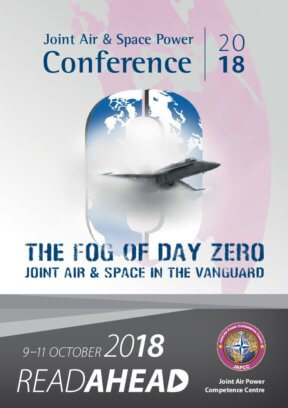Esteemed Colleagues,
It is my privilege and pleasure to serve as the moderator for this year’s Joint Air and Space Power Conference, which will be hosted by the Joint Air Power Competence Centre (JAPCC) 9–11 October 2018 in Essen, Germany. As you have already noted from the cover of this read-ahead, the theme of this year’s conference is:
‘The Fog of Day Zero: Joint Air and Space Power in the Vanguard’
The expression ‘Fog of Day Zero’ is a concept used to indicate that in modern warfare it is not always clear at what point in time there actually is a state of war. The days of nations formally declaring war on one another are past. The uncertain situation is caused by the fact that a modern adversary (who does not even have to be a state actor) can already commit actions which could be seen as a hostile act, but which may not be immediately recognized as such by the victim. For this reason, the expression ‘Day Zero’ is also not well defined in time. It is not a specific point in time nor does it imply a specific length of time.
What ‘Day Zero’ does imply is a situation of uncertainty: is there an attack going on, if so who is the attacker, what are his intentions and does this mean there is a war on? This situation of uncertainty is very often denoted as ‘fog’. Unlike the NATO-USSR stalemate in past decades, a modern adversary has many options to inflict damage, cause casualties, cause confusion and thus influence the strategic and tactical situation, without overt military action, and perhaps without the target being aware it is under attack. An example of unclear hostile acts are cyber-attacks. Cyber-attacks may cause a lot of damage to infrastructure in areas such as energy provision, public transportation, money traffic etc. and be very difficult to attribute to the party responsible. Another option for the attacker is ‘fake news’, which on occasion might be supported by ‘real live coverage of events taking place’ in order to aggravate and destabilize the population and in turn the nation or Alliance. A good example is what is now known as the Ukrainian crisis. Initially, it was not clear whether the ‘rebels’ were in fact dressed-up Russians soldiers … Now there is more clarity, and it is also clear that cyber warfare did play a significant role in this conflict.
Contrary to the situation in the 1990s and 2000s, where NATO was largely unopposed as the sole military superpower on the globe, recent years have seen the re-emergence of near-peer and even peer competitors. The competencies of these Near Peer opponents in cyber, electronic and information warfare, and in some cases space, are known, and growing, and thus so is the complexity of the associated challenges.
Also in NATO countries, a lot is invested in topics like cyber, EW etc. At the same time there is also a strong dependency on electronics and computers, and therefore ‘vulnerability’. The situation in space in that regard is very interesting. A lot of the national systems used by NATO, including some weapon systems, are dependent on electronic provisions like GPS-navigation and timing. If the opponent is able to effectively jam or even take out the GPS, those systems may well be rendered useless.
Satellites are also used for ISR, which has a significant role in information gathering. What is the situation if all of a sudden, reliable information provided by those satellites is no longer available? Should that lead to the conclusion that there is a war on and is it possible to determine who the opponent(s) is/are?
Day Zero, although not well defined, does require that not only the military, but also the civilian population are prepared. This requires resilience to act in uncertain situations, but also to be able to cope with cyber-inflicted damage and disruptions. For the military, it is important to look at weak spots that may have developed over the years. An example is the dependence on contracted civilian companies to provide crucial support. With respect to dependencies, we should consider communication networks, transportation, maintenance and repair and stockpiling. There may not be a problem, but it is certainly worthwhile to take a close look at these subjects and determine how robust and resilient our Alliance is in this regard. Force protection deserves special attention since this may prove to be the game changer in the ‘Fog of Day Zero’ and crucial in preserving our fighting capabilities in the onset of war.
To prepare for the above-described situations requires training and education. People should be trained to follow procedures, but also to think out of the box. They should be trained to think in situations where significant loss of capital assets has taken place, where the opponent’s intentions and manoeuvers are unclear and where even the position and movements of friendly forces may be blurred. And of course, this should be done in a joint manner. Air assets and Special Forces may be the only means available to react quickly to a hostile act; this implies that in training these assets, the colour of uniforms should be irrelevant!
In the following chapters, you will find articles that address aspects of the various topics mentioned above, intended to provide food for thought and to generate critical questions about the way ahead for our Alliance. It will be interesting to see and hear the various introductions during the conference, but also the hopefully lively discussions on these topics. This is your opportunity to contribute and we look forward to seeing and hearing from you in Essen in October!
André van Koningsbrugge
Commodore (ret.), NE N








